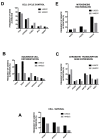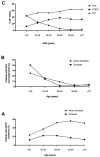Lung Cancers: Molecular Characterization, Clonal Heterogeneity and Evolution, and Cancer Stem Cells
- PMID: 30060526
- PMCID: PMC6116004
- DOI: 10.3390/cancers10080248
Lung Cancers: Molecular Characterization, Clonal Heterogeneity and Evolution, and Cancer Stem Cells
Abstract
Lung cancer causes the largest number of cancer-related deaths in the world. Most (85%) of lung cancers are classified as non-small-cell lung cancer (NSCLC) and small-cell lung cancer (15%) (SCLC). The 5-year survival rate for NSCLC patients remains very low (about 16% at 5 years). The two predominant NSCLC histological phenotypes are adenocarcinoma (ADC) and squamous cell carcinoma (LSQCC). ADCs display several recurrent genetic alterations, including: KRAS, BRAF and EGFR mutations; recurrent mutations and amplifications of several oncogenes, including ERBB2, MET, FGFR1 and FGFR2; fusion oncogenes involving ALK, ROS1, Neuregulin1 (NRG1) and RET. In LSQCC recurrent mutations of TP53, FGFR1, FGFR2, FGFR3, DDR2 and genes of the PI3K pathway have been detected, quantitative gene abnormalities of PTEN and CDKN2A. Developments in the characterization of lung cancer molecular abnormalities provided a strong rationale for new therapeutic options and for understanding the mechanisms of drug resistance. However, the complexity of lung cancer genomes is particularly high, as shown by deep-sequencing studies supporting the heterogeneity of lung tumors at cellular level, with sub-clones exhibiting different combinations of mutations. Molecular studies performed on lung tumors during treatment have shown the phenomenon of clonal evolution, thus supporting the occurrence of a temporal tumor heterogeneity.
Keywords: cancer stem cells; genomic profiling; membrane cell markers; non-small cell lung cancer; small cell lung cancer; tumor xenotransplantation assay.
Conflict of interest statement
The authors have no any conflict of interest to declare.
Figures





References
-
- Raaschou-Nielsen O., Andersen Z.J., Beelen R., Samoli E., Stafoggia M., Wenmayr G., Hoffmann B., Fischer P., Nieuwenhuijsen M.J., Brunekreef B., et al. Air pollution and lung cancer incidence in 17 European cohorts: Prospective analyses from the European Study of cohorts for air pollution effects [ESCAPE] Lancet Oncol. 2013;14:813–822. doi: 10.1016/S1470-2045(13)70279-1. - DOI - PubMed
Publication types
LinkOut - more resources
Full Text Sources
Other Literature Sources
Research Materials
Miscellaneous

